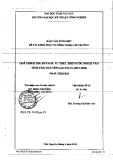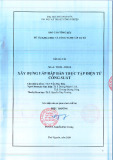
The
N
-acetylglutamate synthase/
N
-acetylglutamate kinase
metabolon of
Saccharomyces cerevisiae
allows co-ordinated
feedback regulation of the first two steps in arginine biosynthesis
Katia Pauwels, Agnes Abadjieva, Pierre Hilven, Anna Stankiewicz and Marjolaine Crabeel
Department of Genetics and Microbiology of the Vrije Universiteit Brussel, Brussels, Belgium
In Saccharomyces cerevisiae, which uses the nonlinear
pathway of arginine biosynthesis, the first two enzymes,
N-acetylglutamate synthase (NAGS) and N-acetylglutamate
kinase (NAGK), are controlled by feedback inhibition. We
have previously shown that NAGS and NAGK associate in
a complex, essential to synthase activity and protein level
[Abadjieva, A., Pauwels, K., Hilven, P. & Crabeel, M. (2001)
J. Biol. Chem. 276, 42869–42880].
The NAGKs of ascomycetes possess, in addition to the
catalytic domain that is shared by all other NAGKs and
whose structure has been determined, a C-terminal domain
of unknown function and structure. Exploring the role of
these two domains in the synthase/kinase interaction, we
demonstrate that the ascomycete-specific domain is required
to maintain synthase activity and protein level.
Previous results had suggested a participation of the third
enzyme of the pathway, N-acetylglutamylphosphate reduc-
tase, in the metabolon. Here, genetic analyses conducted in
yeast at physiological level, or in a heterologous background,
clearly demonstrate that the reductase is dispensable for
synthase activity and protein level.
Most importantly, we show that the arginine feedback
regulation of the NAGS and NAGK enzymes is mutually
interdependent. First, the kinase becomes less sensitive to
arginine feedback inhibition in the absence of the synthase.
Second, and as in Neurospora crassa, in a yeast kinase
mutant resistant to arginine feedback inhibition, the
synthase becomes feedback resistant concomitantly.
We conclude that the NAGS/NAGK metabolon pro-
motes the co-ordination of the catalytic activities and feed-
back regulation of the first two, flux controlling, enzymes of
the arginine pathway.
Keywords:yeast;N-acetylglutamate synthase; N-acetylglu-
tamate kinase; metabolon; co-ordinated feedback inhibition.
De novo arginine biosynthesis in plants and microorganisms
occurs in eight biochemical steps starting from glutamate. In
the fifth step of this pathway ornithine is generated from
N-acetylornithine. Two different ornithine synthesis reac-
tions can be distinguished. In the linear pathway, ornithine
is generated through the hydrolysis of N-acetylornithine. In
the cyclic pathway, the acetyl group of N-acetylornithine is
transferred to glutamate, thereby regenerating N-acetylglu-
tamate (Fig. 1). Because it avoids the acetyl-CoA consu-
ming initial step, catalysed by N-acetylglutamate synthase
(NAGS) (EC 2.3.1.1), the cyclic pathway is energetically
more favourable. However, an organism, which regenerates
N-acetylglutamate through ornithine synthesis, still requires
the synthase in order to ensure a constant level of acetylated
compounds during cell growth. Therefore an anaplerotic
role is attributed to acetylglutamate synthase in organisms
using the cyclic pathway of ornithine synthesis [1,2].
The linear pattern of ornithine synthesis is found in
Escherichia coli and some other bacteria and archea [1–5].
The cyclic pattern is more widespread among the procary-
otes [6–13], and it is observed in all investigated ascomyce-
tes, including Candida utilis [14], Saccharomyces cerevisiae
[15], Neurospora crassa [2], and in Chlamydomonas algae
[16]. In the fungi, ornithine synthesis proceeds entirely in the
mitochondria [17,18].
Control of the metabolic flux through a biosynthetic
pathway usually occurs at the level of the first committed
step and is often mediated by the end product of the
pathway. This classical mechanism operates in organisms
using the linear pathway of arginine synthesis: arginine
exerts feedback inhibition on N-acetylglutamate synthase in
E. coli and Salmonella typhimurium [19–21]. In pathways
where acetylglutamate is regenerated, the second enzyme of
arginine biosynthesis, N-acetylglutamate kinase (NAGK)
(EC 2.7.2.8) becomes the main controlling step. Feedback
inhibition of the kinase by arginine has been demonstrated
in several bacteria [7,22,23]. Yet, metabolic control should
occur on the production of acetylglutamate, regardless of its
origin. Therefore, feedback inhibition on both the synthase
and the kinase is believed to be general for organisms using
Correspondence to M. Crabeel, Department of Genetics and
Microbiology of the Vrije Universiteit Brussel, c/o CERIA-COOVI,
Emile Gryson avenue 1, B-1070 Brussels, Belgium.
Fax: + 32 2 526 72 73, Tel.: + 32 2 526 72 84,
E-mail: mcrabeel@vub.ac.be
Abbreviations:NAGS,N-acetylglutamate synthase; NAGK,
N-acetylglutamate kinase; NAGPR, N-acetylglutamylphosphate
reductase; CD, catalytic active domain; ASD, ascomycetes specific
domain.
Enzymes:N-acetylglutamate synthase (EC 2.3.1.1), N-acetylglutamate
kinase (EC 2.7.2.8), N-acetylglutamylphosphate reductase
(EC 1.2.1.38).
(Received 25 November 2002, revised 14 January 2003,
accepted 22 January 2003)
Eur. J. Biochem. 270, 1014–1024 (2003) FEBS 2003 doi:10.1046/j.1432-1033.2003.03477.x






























